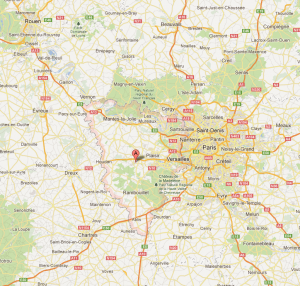Equine Herpes Virus – 1 (EHV -1) Alert Dept 78 YVELINES
Posted by on Oct 29, 2012 in Association News | 0 commentsYvelines is situated on the Western boundary of the Parisien region Ile -de-France. There have been three new outbreaks of EHV-1. The pin marks the centre of Yveslines, not the outbreak location.
The copy on this page is from the AHT link below.
http://www.aht.org.uk/icc/Interim_Report16_october12.html
Interim Report – October 2012 #16 (26.10.12)
France
Equine Herpes Virus-1 (EHV-1) – Outbreak Update
Following the confirmation of three outbreaks of equine herpes virus-1 (EHV-1) since 8th October 2012 in Yvelines, Réseau d’Epidémio-Surveillance en Pathologie Equine (RESPE) have provided an update on the situation.
To date, the outbreaks have affected horses used for sport and leisure activities which are located within a fifty kilometre radius of the centre of Yvelines. There are no other suspected outbreaks to date. Affected horses have shown neurological signs (ataxia), respiratory signs such as a clear nasal discharge and swelling of the limbs.
On 8th October the first outbreak was reported at an equestrian centre and one horse tested positive. The affected horse was vaccinated, showed neurological signs and was euthanized. Movement restrictions and precautionary measures have been applied and no horses have entered or left the premises for several weeks.
The second outbreak was reported on 15th October and two horses tested positive to EHV-1. One of the horses was unvaccinated and showed low grade neurological signs. The second horse was vaccinated and asymptomatic. Movement restrictions have been applied since the first horse showed clinical signs of the disease and a competition due to be held on the premises was cancelled. Precautionary measures have also been applied.
On 24th October the third outbreak was confirmed and two vaccinated horses were affected. One horse showed respiratory signs and the second horse was asymptomatic. Further samples have been taken and diagnostic testing is in progress. Movement restrictions and precautionary measures have been applied to the premises.
An epidemiological investigation is ongoing, and links between the three affected premises have not been made. The movement of horses at the second and third affected premises may have resulted disease transmission. The outbreak at the premises which was first affected appears to be due to viral reactivation of the infection.
The three confirmed outbreaks of EHV-1 highlight that the virus is circulating in Yvelines. Horse owners and riders, particularly those involved in competition, have been asked to be vigilant in the forthcoming weeks.
Regards
International Collating Centre


